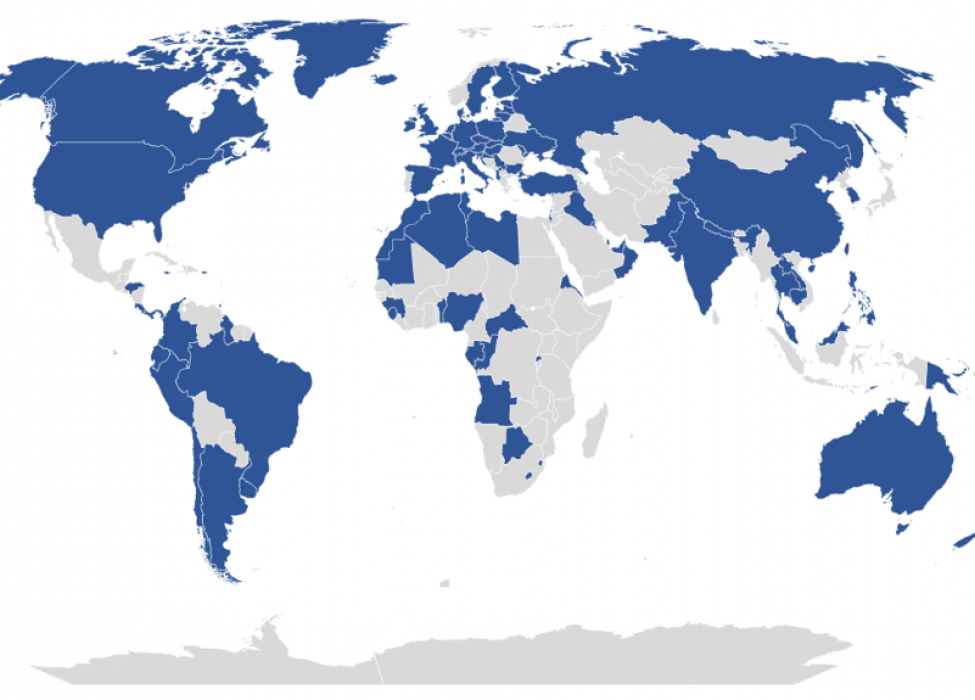Restrictions and mandates for the unvaccinated - the new normal?
Vaccines have transformed the world of pandemic policy and the Oxford COVID-19 Government Response Tracker is adapting. The team explain the changes in details.

Over the past 12 months, vaccination has become a critical layer of defence against the COVID-19 pandemic, at least for those countries lucky enough to have access to vaccines.
As governments rush to get everyone jabbed, they have increasingly turned to two new tools:
- Restrictions targeting unvaccinated people specifically
- Mandates requiring certain groups of people, and sometimes the whole population, to get vaccinated.
The Oxford COVID-19 Government Response Tracker (OxCGRT), the world’s key data source for tracking and comparing COVID-19 response measures, is looking at how these types of policies are being used around the world. What have we found so far?
As COVID-19 vaccines have become more available over the past two years, government policies have increasingly aimed to incentivise uptake. As the maps show, 48 countries have mandates in place, soon to be 49 with Belgium planning to introduce a mandate in April 2022. 107 countries apply restrictions like access to shops, transport, or schools differently depending on whether people are vaccinated or not. For example, Italy mandated healthcare workers to be vaccinated in April 2021, and Israel introduced their Green Pass in March 2021, enabling greater freedoms for those who had received two COVID-19 vaccinations.
On the other hand, some countries have not put in place these kinds of measures, perhaps because the level of vaccination remains low, or because of concerns over mandating health measures. For example, there are no official vaccination mandates or passes affording freedoms based on vaccination status in Mexico, and in several countries in sub-saharan Africa including Ethiopia, Tanzania, and South Africa.
Mandates have also been introduced at the regional level. For example, the mandatory vaccination recorded for China reflects the mandatory vaccination in place in Beijing for selected groups.

Countries with differentiated coding in place at some point from 1 Jan 2022 - 2 Mar 2022

Countries with vaccine mandates by category (blue: vaccine mandate in place; orange: vaccine mandate upcoming)
In some cases, the values on the Stringency Index (SI) for vaccinated and non-vaccinated are very similar, and in others very different. Non-vaccinated people face substantial restrictions in places:
- The example of Austria is particularly notable, having introduced a stay-at-home order for non-vaccinated people in November 2021.
- France also has a large gap in policy stringency for vaccinated and non-vaccinated people, as a vaccine pass is required to access inter-regional travel and long-distance public transport, and to visit venues including cinemas, theatres, bars, and some stores.
- In Germany, too, the ‘2G and 3G’ rules limit access rights based on vaccination, recovery, or PCR test status, for access to cultural and leisure facilities, retail, buses and trains, and long-term care facilities.
- Armed police in Uganda are reported to have removed unvaccinated bus travellers to vaccinate them in a tent at the side of the road, highlighting stringent approaches to enforcement for those without vaccination evidence.
However, in most countries the differences are not so severe. Overall, in the 107 countries with differentiated policies, the average difference in the Stringency Index for vaccinated and unvaccinated people is 8.33.
The indicators where we observe the most variation between vaccinated and non-vaccinated policies are C2 - Workplace closures, C3 - Public events, C5 - Public transport, and C7 - Internal movement. We observe differences in Stringency Index values between non-vaccinated and vaccinated people covering a wide range; from 30-60 points. Non-vaccinated people are subject to much stricter policies than vaccinated people in a number of countries.
| Country | Maximum difference |
| France | 46.30 |
| Germany | 45.37 |
| Ecuador | 43.52 |
| Lithuania | 42.59 |
| Turkey | 38.89 |
| Ukraine | 38.89 |
| Oman | 38.89 |
| Hungary | 37.96 |
| Morocco | 37.04 |
| Italy | 37.04 |
| Country | Average difference |
| Lithuania | 41.89 |
| Hungary | 37.96 |
| Germany | 29.94 |
| Morocco | 25.51 |
| Ukraine | 24.20 |
| Colombia | 22.81 |
| France | 22.38 |
| Italy | 21.16 |
| Pakistan | 21.06 |
| Argentina | 20.73 |
- Countries including Indonesia, Tajikistan and Turkmenistan, have very wide-reaching mandates, having made vaccination mandatory for the entire adult population. Ecuador has mandated vaccination for all those over the age of 5, and Puerto Rico requires those over 5 to be vaccinated to attend school. Costa Rica mandates all children between 3 and 18 years be vaccinated.
- In the majority of places mandating vaccination - such as Poland, Pakistan, New Zealand, and Saudi Arabia, these policies are very targeted; only for selected groups based on occupation or clinical risk, with the most commonly mandated categories being government officials and public sector workers, healthcare workers, and teachers.
Our ongoing data collection is providing a critical evidence base to answer this vital question. While our vaccine mandate (V4) data is currently available, like all our measures, from 1 January 2020, information on differentiated policies on vaccinated and unvaccinated people is still being collected for 2021. Once this information has been brought together, researchers and governments will be able to gain a much deeper understanding of how policy incentives can best contribute to greater uptake of vaccines.
As a number of countries move to rollback restrictions following an Omicron wave, a key question is whether vaccine mandates and restrictions on the unvaccinated represent a temporary measure, or are instead part of a new equilibrium of "living with the virus". At present, many measures remain in force, but it is too soon to tell how long for. The OxCGRT will continue to track these measures going forward, keeping pace with further evolutions of government responses into the next phase of the COVID-19 challenge.
We are now publishing a pilot dataset (from 1 January 2022) that reports two policy values if there are different rules for vaccinated and non-vaccinated people, for example the need for a vaccine pass to visit a bar, large sporting event, or a stay-at-home order for non-vaccinated people in Austria in November 2021. These are reported for C1, C2, C3, C4, C5, C6, C7, C8, H6 and H8 indicators. There are therefore now 10 indicators with differentiated vaccination policy coding.
We now report four different Stringency Index, Government Response Index, and Containment and Health Index values:
- Non-vaccinated Stringency Index
- Vaccinated Stringency Index
- Average Stringency Index
- Percentage population vaccinated weighted average (using external data source for national dataset )
Once we have collected data on differentiated policies for all of 2021, our main dataset will be updated to reflect these new measures.
We have also added an indicator for mandatory vaccination (V4) to our main dataset. This records the presence of a mandatory, non-optional vaccination policy on the date it comes into effect, using the 53 categories included in the V indicators.
You can stay on track of changes in the database by signing up to our technical data users mailing list.
How will this affect the existing data?
Restrictions for the unvaccinated: The main CSVs will continue to report the non-vaccinated value for the time being, which is consistent with the reporting from the last two years. We plan to complete the data collection for the vaccinated policy values over the next few months, then will update the existing .csvs accordingly.
Vaccine mandates: This data will be added to the main .csv files on the main OxCGRT Github page, and the codebook and interpretation guide will be updated accordingly.
Which SI is the one reported in the main .csvs?
The Stringency Index (and other index values) in the main .csvs is equivalent to the new non-vaccinated index value.
Where can I access the data?
The new differentiated vaccination policies folder containing data and documentation is currently hosted on our Github scratchpad. The new V4 indicator is now published in our existing .csv files and detailed in documentation here.
Coding interpretation subtleties to note
When trying to fit heterogenous policies into simple coding structure, we exercise situational judgment for every case. We publish an interpretation guide, to ensure standardisation and consistency across data collectors, and to enable data users to understand the finer points of coding. Key points to note for our differentiated vaccination policy coding are as follows:
- If non-vaccinated people are required to present a vaccine certificate, or negative PCR test to access a freedom, we report this as a closure.
- We report this as a closure if people attending schools (students), or workplaces (visitors to bars, nightclubs, shops, those using public transport), must be vaccinated to access this freedom. If staff are required to be vaccinated, this is not captured here, but in our V4 indicator (mandatory vaccination) – see codebook for further detail.
Disclaimer
We very strongly emphasise that this is a pilot .csv, not the finished product, and is subject to change. We therefore recommend exercising caution in building scripts based on this. As per our main repo, the data are regularly reviewed, and are subject to change. We therefore recommend downloading the most recent data and stating the date of download if using the data. Users writing scripts to read the data automatically will want to check back frequently to make sure the data format does not change.

